Climate Change Effects on Texas Dryland Winter Wheat Yields
Abstract
1. Introduction
2. Materials and Methods
2.1. Data
2.2. APEX
2.3. CMIP5
3. Results
3.1. Data Analysis
3.1.1. Fertilizer Application in Wheat Production in Texas
3.1.2. Average Wheat Yields in Texas
3.2. Analysis of Historical Climate Patterns
3.3. APEX and Simulated Impacts
Simulated Winter Wheat Yields under RCP Scenarios
4. Conclusions and Recommendations
4.1. Conclusions
4.2. Recommendations
Author Contributions
Funding
Institutional Review Board Statement
Data Availability Statement
Conflicts of Interest
References
- Shrestha, R.; Thapa, S.; Xue, Q.; Stewart, B.A.; Blaser, B.C.; Ashiadey, E.K.; Rudd, J.; Devkota, R.N. Winter wheat response to climate change under irrigated and dryland conditions in the US southern High Plains. J. Soil Water Conserv. 2019, 75, 112–122. [Google Scholar] [CrossRef]
- USDA. Wheat Overview. USDA ERS—Wheat. 2022. Available online: https://www.ers.usda.gov/topics/crops/wheat/ (accessed on 1 December 2022).
- Texas Almanac. Principal Crops in Texas. Principal Crops in Texas. Texas Almanac. 2020. Available online: https://texasalmanac.com/topics/agriculture/principal-crops-texas (accessed on 1 November 2021).
- Kothari, K.; Ale, S.; Attia, A.; Rajan, N.; Xue, Q.; Munster, C.L. Potential climate change adaptation strategies for winter wheat production in the Texas High Plains. Agric. Water Manag. 2019, 225, 105764. [Google Scholar] [CrossRef]
- National Agriculture Statistics Service. Quick Stats. 2021. Available online: https://quickstats.nass.usda.gov/ (accessed on 10 March 2021).
- Whitlock, J. Texas Wheat Acres down, Prices up. Texas Farm Bureau. Available online: https://texasfarmbureau.org/texas-wheat-acres-down-prices-up/ (accessed on 1 November 2021).
- Texas Crop Weather. USDA National Agricultural Statistics Service. 2006. Available online: https://www.nass.usda.gov/Statistics_by_State/Texas/Publications/Crop_Progress_&_Condition/prevCW/index.php (accessed on 2 December 2022).
- Historical Data and Conditions. Drought.Gov. (n.d.). Available online: https://www.drought.gov/historical-information?state=texas&dataset=0&selectedDateUSDM=20100706&dateRangeUSDM=2000-2021 (accessed on 11 November 2021).
- Ray, R.L.; Fares, A.; Risch, E. Effects of Drought on Crop Production and Cropping Areas in Texas. Agric. Environ. Lett. 2018, 3, 170037. [Google Scholar] [CrossRef]
- Chen, Y.; Marek, G.W.; Marek, T.H.; Porter, D.O.; Brauer, D.K.; Srinivasan, R. Modeling climate change impacts on blue, green, and grey water footprints and crop yields in the Texas High Plains, USA. Agric. For. Meteorol. 2021, 310, 108649. [Google Scholar] [CrossRef]
- Goedde, L.; Katz, J.; Ménard, A.; Revellat, J. Agriculture’s Connected Future: How Technology Can Yield New Growth. McKinsey & Company. 2020. Available online: https://www.mckinsey.com/industries/agriculture/our-insights/agricultures-connected-future-how-technology-can-yield-new-growth (accessed on 2 January 2023).
- Lake, I.R.; Hooper, L.; Abdelhamid, A.; Bentham, G.; Boxall, A.B.; Draper, A.; Fairweather-Tait, S.; Hulme, M.; Hunter, P.R.; Nichols, G.; et al. Climate Change and Food Security: Health Impacts in Developed Countries. Environ. Health Perspect. 2012, 120, 1520–1526. [Google Scholar] [CrossRef] [PubMed]
- Zabel, F.; Putzenlechner, B.; Mauser, W. Global Agricultural Land Resources—A High Resolution Suitability Evaluation and Its Perspectives until 2100 under Climate Change Conditions. PLoS ONE 2014, 9, e107522. [Google Scholar] [CrossRef] [PubMed]
- Xue, Q.; Rudd, J.C.; Liu, S.; Jessup, K.E.; Devkota, R.N.; Mahano, J.R. Yield Determination and Water-Use Efficiency of Wheat under Water-Limited Conditions in the U.S. Southern High Plains. Crop Sci. 2014, 54, 34–47. [Google Scholar] [CrossRef]
- Zhu, P.; Burney, J. Temperature-driven harvest decisions amplify US winter wheat loss under climate warming. Glob. Chang. Biol. 2020, 27, 550–562. [Google Scholar] [CrossRef]
- FAO. Climate Change and Food Security: Risks and Responses; Food and Agriculture Organization of the United Nations: Rome, Italy, 2016; Available online: https://www.fao.org/3/i5188e/I5188E.pdf (accessed on 18 January 2023).
- Cui, X. Climate change and adaptation in agriculture: Evidence from US cropping patterns. J. Environ. Econ. Manag. 2020, 101, 102306. [Google Scholar] [CrossRef]
- Zhao, C.; Liu, B.; Piao, S.; Wang, X.; Lobell, D.B.; Huang, Y.; Huang, M.T.; Yao, Y.T.; Bassu, S.; Ciais, P.; et al. Temperature increase reduces global yields of major crops in four independent estimates. Proc. Natl. Acad. Sci. USA 2017, 114, 9326–9331. [Google Scholar] [CrossRef] [PubMed]
- Asseng, S.; Ewert, F.; Rosenzweig, C.; Jones, J.W.; Hatfield, J.L.; Ruane, A.C.; Boote, K.J.; Thorburn, P.J.; Rötter, R.P.; Cammarano, D.; et al. Uncertainty in simulating wheat yields under climate change. Nat. Clim. Chang. 2013, 3, 827–832. [Google Scholar] [CrossRef]
- Olmstead, A.L.; Rhode, P.W. Adapting North American wheat production to climatic challenges, 1839–2009. Proc. Natl. Acad. Sci. USA 2010, 108, 480–485. [Google Scholar] [CrossRef]
- Sloat, L.L.; Davis, S.J.; Gerber, J.S.; Moore, F.C.; Ray, D.K.; West, P.C.; Mueller, N.D. Climate adaptation by crop migration. Nat. Commun. 2020, 11, 1243. [Google Scholar] [CrossRef]
- Wang, X.; Williams, J.R.; Gassman, P.W.; Baffaut, C.; Izaurralde, R.C.; Jeong, J.; Kiniry, J.R. EPIC and APEX: Model Use, Calibration, and Validation. Trans. ASABE 2012, 55, 1447–1462. [Google Scholar] [CrossRef]
- Gassman, P.W.; Williams, J.R.; Benson, V.W.; Izaurralde, R.C.; Hauck, L.M.; Jones, C.A.; Atwood, J.D.; Kiniry, J.R.; Flowers, J.D. Historical development and applications of the epic and Apex Models. In Proceedings of the 2004 ASAE Annual Meeting, Ottawa, ON, Canada, 1–4 August 2004. [Google Scholar] [CrossRef][Green Version]
- Williams, J.R.; Izaurralde, R.C. The APEX model. In Watershed Models; Singh, V.P., Frevert, D.K., Eds.; CRC Press: Boca Raton, FL, USA, 2006; pp. 437–482. [Google Scholar]
- Wang, X.; Hoffman, D.W.; Wolfe, J.E.; Williams, J.R.; Fox, W.E. Modeling the Effectiveness of Conservation Practices at Shoal Creek Watershed, Texas, using APEX. Trans. ASABE 2009, 52, 1181–1192. Available online: http://gateway.webofknowledge.com/gateway/Gateway.cgi?GWVersion=2&SrcApp=PARTNER_APP&SrcAuth=Agronomy_sub&KeyUT=WOS:000269783100013&DestLinkType=FullRecord&DestApp=WOS_CPL&UsrCustomerID=9992b2403adf8c36119d0b6fce39b97c (accessed on 6 June 2023). [CrossRef]
- Gassman, P.W.; Williams, J.R.; Wang, X.; Saleh, A.; Osei, E.; Hauck, L.M.; Izaurralde, R.C.; Flowers, J.D. The Agricultural Policy/Environmental eXtender (APEX) Model: An Emerging Tool for Landscape and Watershed Environmental Analyses. Trans. ASABE 2010, 53, 711–740. Available online: http://gateway.webofknowledge.com/gateway/Gateway.cgi?GWVersion=2&SrcApp=PARTNER_APP&SrcAuth=Agronomy_sub&KeyUT=WOS:000280272500008&DestLinkType=FullRecord&DestApp=WOS_CPL&UsrCustomerID=9992b2403adf8c36119d0b6fce39b97c (accessed on 1 January 2024). [CrossRef]
- Williams, J.R.R.C.I.; Steglich, E.M. Agricultural Policy/Environmental eXtender Model: Theoretical Documentation; Texas A&M AgriLife Blackland Research and Extension Center: Temple, TX, USA, 2012.
- Luo, Y.; Wang, H. Modeling the impacts of agricultural management strategies on crop yields and sediment yields using APEX in Guizhou Plateau, southwest China. Agric. Water Manag. 2019, 216, 325–338. [Google Scholar] [CrossRef]
- Osei, E.; Jafri, S.H.; Saleh, A.; Gassman, P.W.; Gallego, O. Simulated Climate Change Impacts on Corn and Soybean Yields in Buchanan County, Iowa. Agriculture 2023, 13, 268. [Google Scholar] [CrossRef]
- Texas A&M AgriLife. (n.d.). Epic & Apex Models. EPIC & APEX Models. Available online: https://epicapex.tamu.edu/about/apex/ (accessed on 18 April 2023).
- Irmak, S. Impacts of Extreme Heat Stress and Increased Soil Temperature on Plant Growth and Development. CropWatch. 2016. Available online: https://cropwatch.unl.edu/2016/impacts-extreme-heat-stress-and-increased-soil-temperature-plant-growth-and-development (accessed on 30 November 2022).
- Pryor, S.C.; Scavia, D.; Downer, C.; Gaden, M.; Iverson, L.; Nordstrom, R.; Patz, J.; Robertson, G.P. Ch. 18: Midwest. In Climate Change Impacts in the United States: The Third National Climate Assessment; Melillo, J.M., Richmond, T., Yohe, G.W., Eds.; U.S. Global Change Research Program: Washington, DC, USA, 2014; pp. 418–440. [Google Scholar]
- Bezner Kerr, R.; Hasegawa, T.; Lasco, R.; Bhatt, I.; Deryng, D.; Farrell, A.; Gurney-Smith, H.; Ju, H.; Lluch-Cota, S.; Meza, F.; et al. Food, Fibre, and Other Ecosystem Products. In Climate Change 2022: Impacts, Adaptation and Vulnerability; Contribution of Working Group II to the Sixth Assessment Report of the Intergovernmental Panel on Climate Change; Pörtner, H.-O., Roberts, D., Tignor, M., Poloczanska, E., Mintenbeck, K., Alegría, A., Craig, M., Langsdorf, S., Löschke, S., Möller, V., et al., Eds.; Cambridge University Press: Cambridge, UK; New York, NY, USA, 2022; pp. 713–906. [Google Scholar]
- Guo, H.; Xia, Y.; Jin, J.; Pan, C. The impact of climate change on the efficiency of agricultural production in the world’s main agricultural regions. Environ. Impact Assess. Rev. 2022, 97, 106891. [Google Scholar] [CrossRef]
- Talebizadeh, M.; Moriasi, D.; Gowda, P.; Steiner, J.L.; Tadesse, H.K.; Nelson, A.M.; Starks, P. Simultaneous calibration of evapotranspiration and crop yield in agronomic system modeling using the APEX model. Agric. Water Manag. 2018, 208, 299–306. [Google Scholar] [CrossRef]
- Francesconi, W.; Smith, D.R.; Heathman, G.C.; Wang, X.; Williams, C.O. Monitoring and APEX Modeling of No-Till and Reduced-Till in Tile-Drained Agricultural Landscapes for Water Quality. Trans. ASABE 2014, 57, 777–789. [Google Scholar] [CrossRef]
- Tuppad, P.; Santhi, C.; Wang, X.; Williams, J.R.; Srinivasan, R.; Gowda, P.H. Simulation of Conservation Practices Using the APEX Model. Appl. Eng. Agric. 2010, 26, 779–794. [Google Scholar] [CrossRef]
- Williams, J.R.; Arnold, J.G.; Srinivasan, R. The APEX Model; BRC Report No. 00-06; Blackland Research Center, Texas Agri-cultural Experiment Station, Texas Agricultural Extension Service, Texas A&M University System: Temple, TX, USA, 2000.
- Melillo, J.M.; Richmond, T.C.; Yohe, G.W. (Eds.) Climate Change Impacts in the United States: The Third National Climate Assessment; U.S. Global Change Research Program: Washington, DC, USA, 2014; p. 841. [CrossRef]
- Wakatsuki, H.; Ju, H.; Nelson, G.C.; Farrell, A.D.; Deryng, D.; Meza, F.; Hasegawa, T. Research trends and gaps in climate change impacts and adaptation potentials in major crops. Curr. Opin. Environ. Sustain. 2023, 60, 101249. [Google Scholar] [CrossRef]
- Doulabian, S.; Golian, S.; Toosi, A.S.; Murphy, C. Evaluating the effects of climate change on precipitation and temperature for Iran using RCP scenarios. J. Water Clim. Chang. 2020, 12, 166–184. [Google Scholar] [CrossRef]
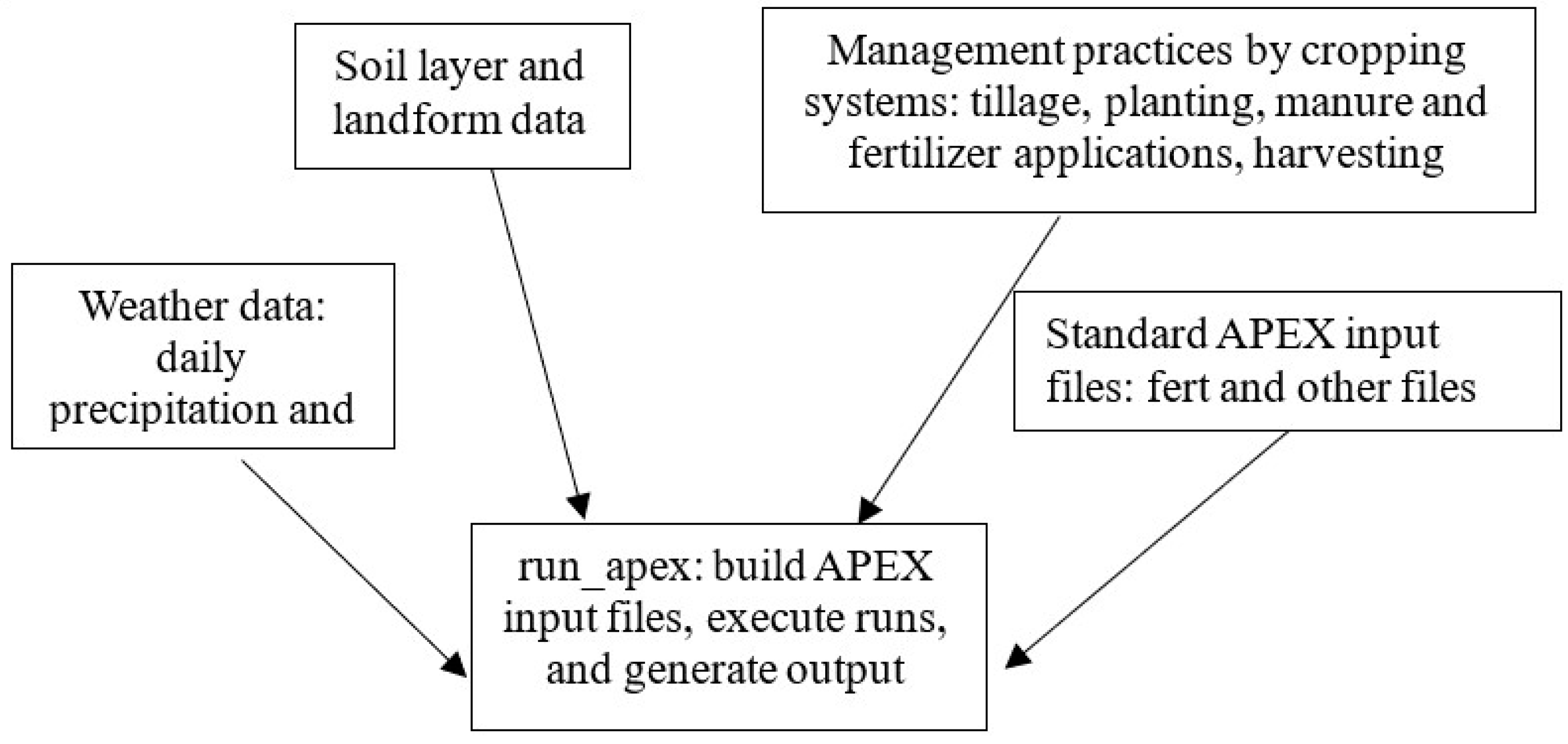
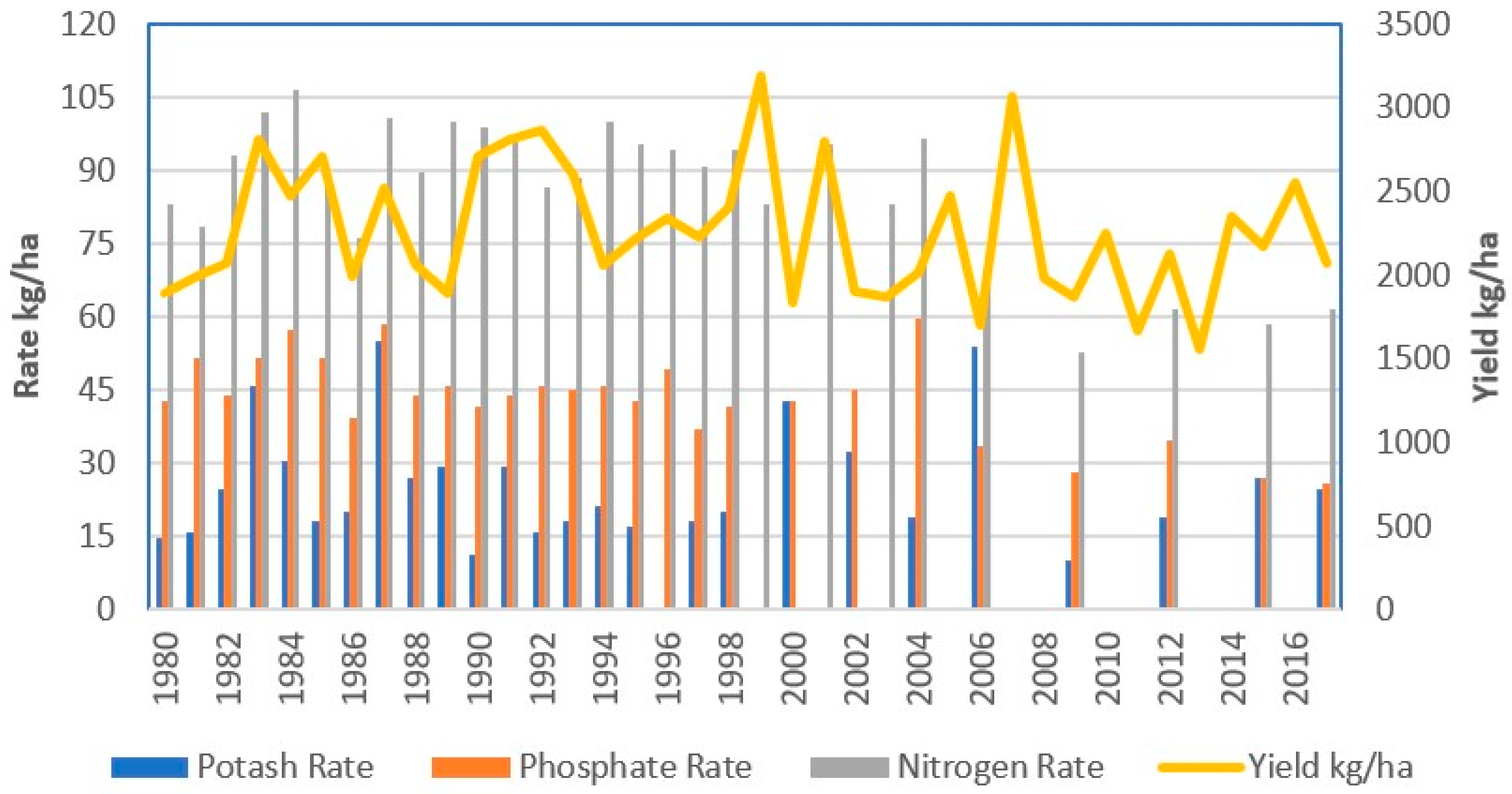
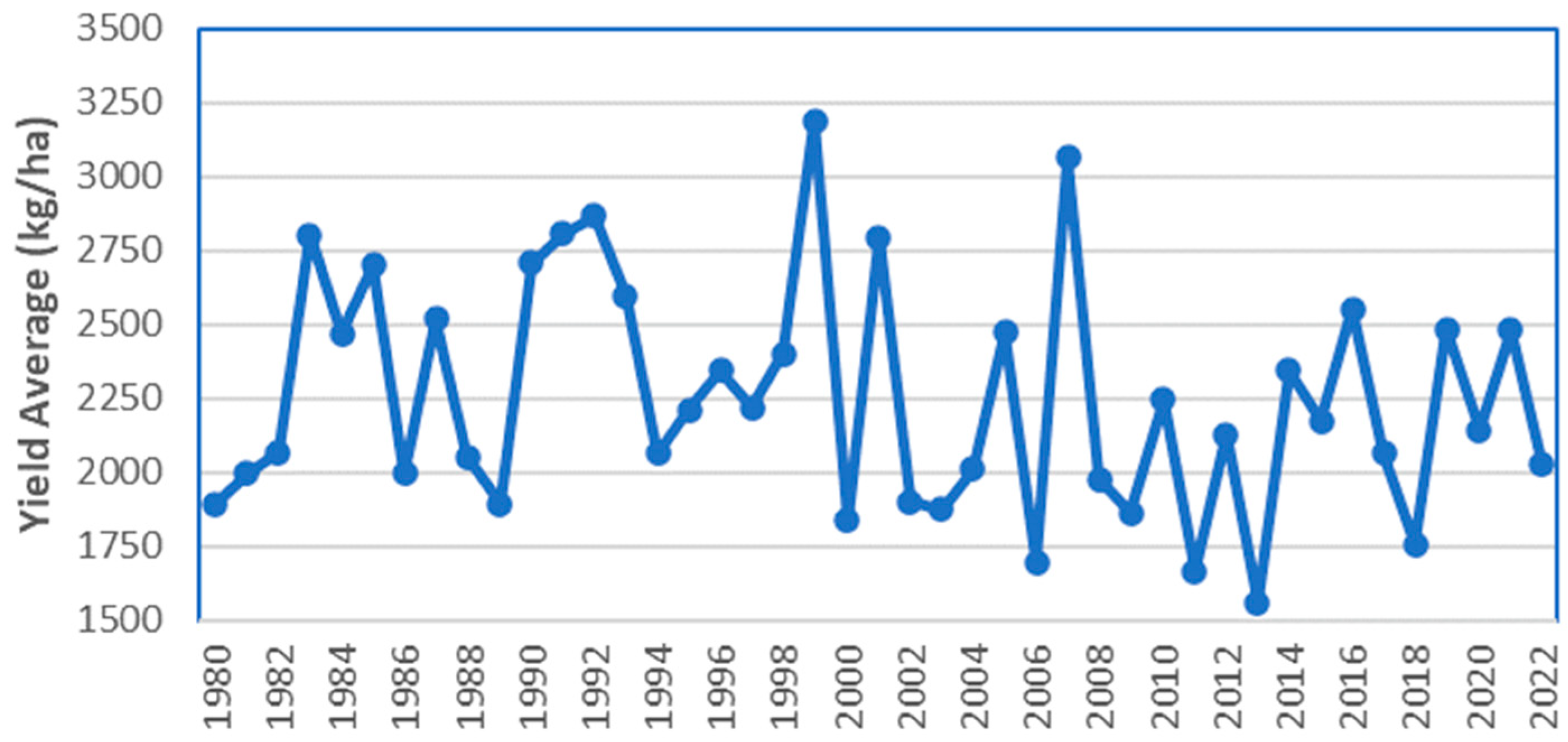
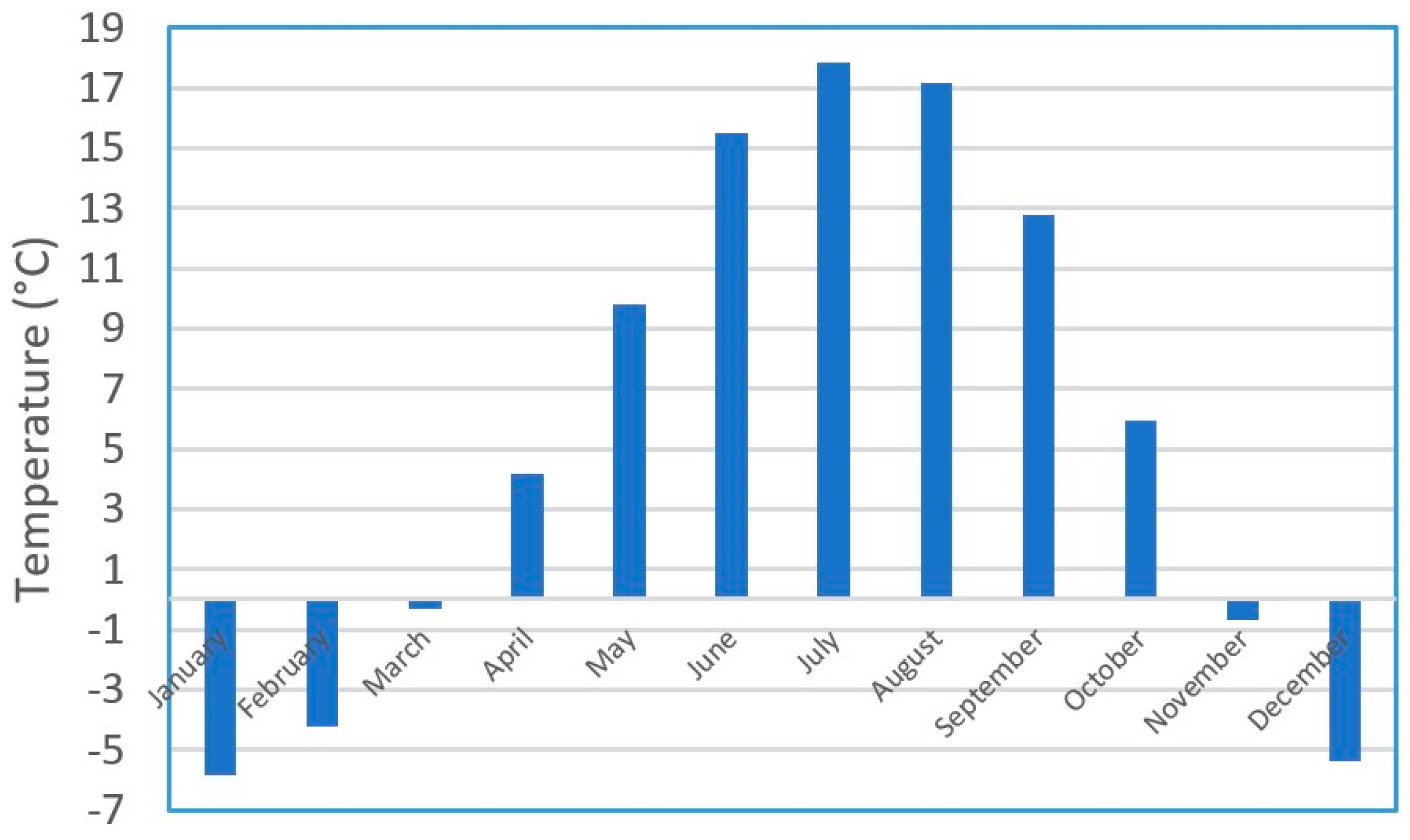
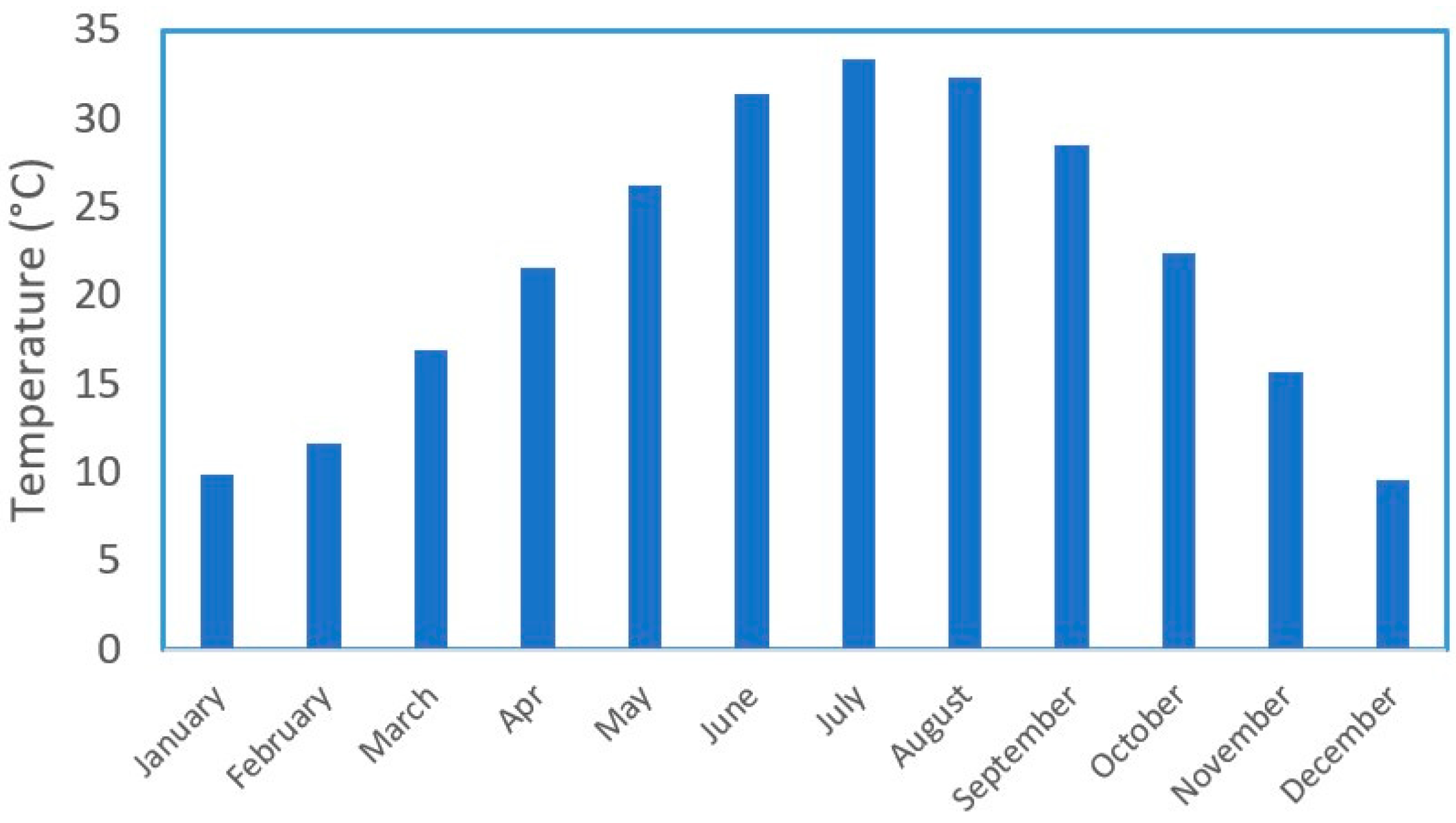
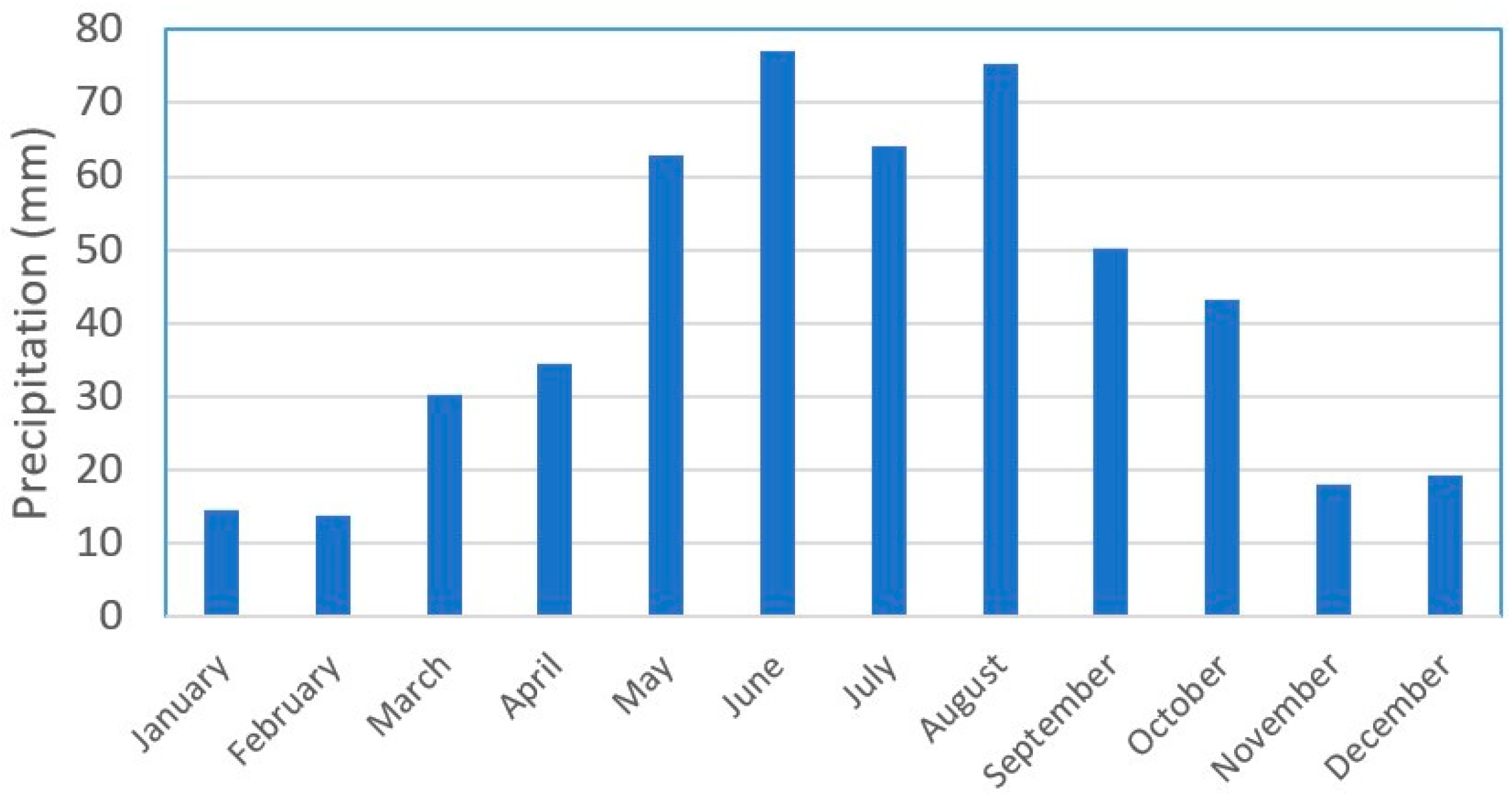
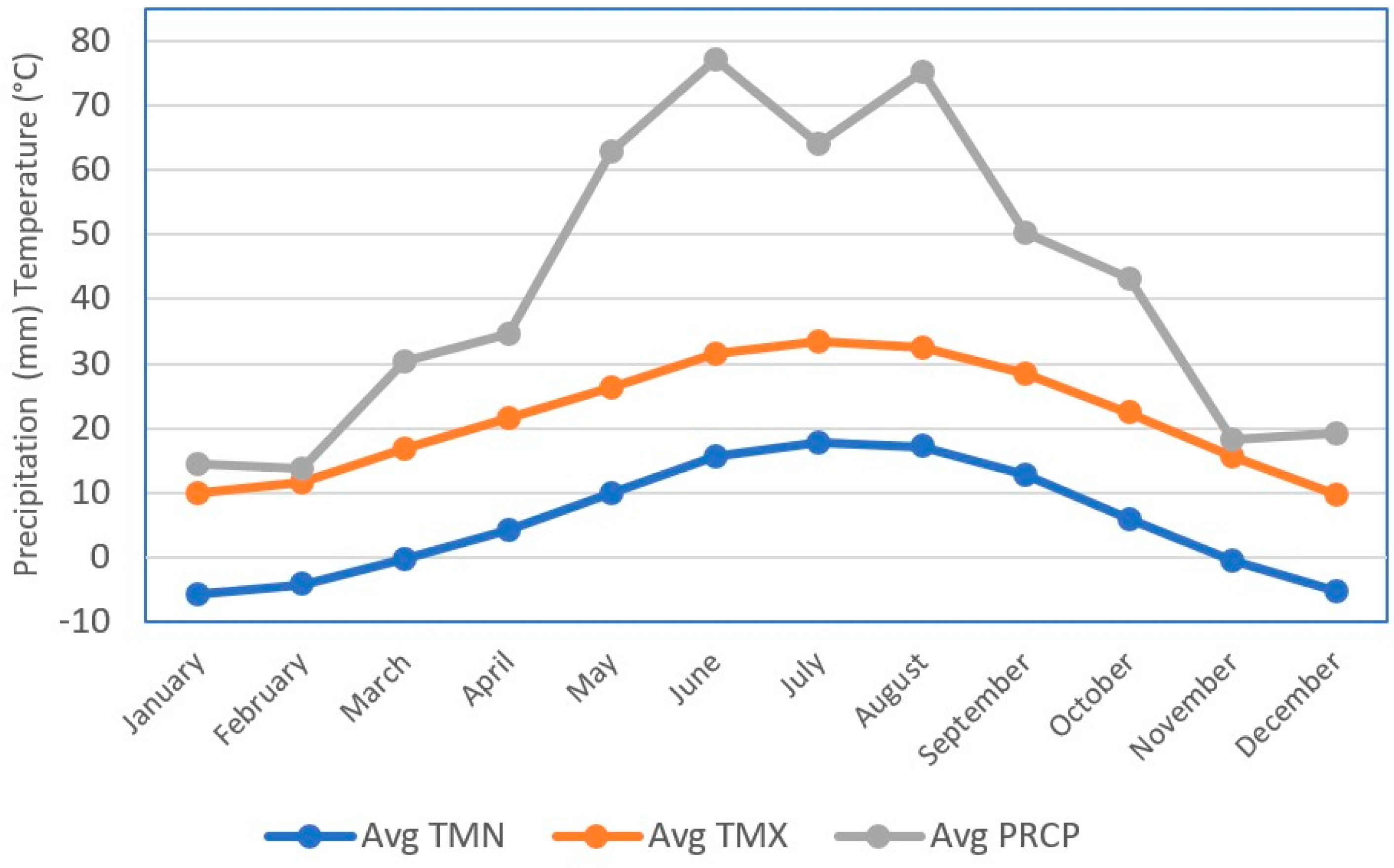
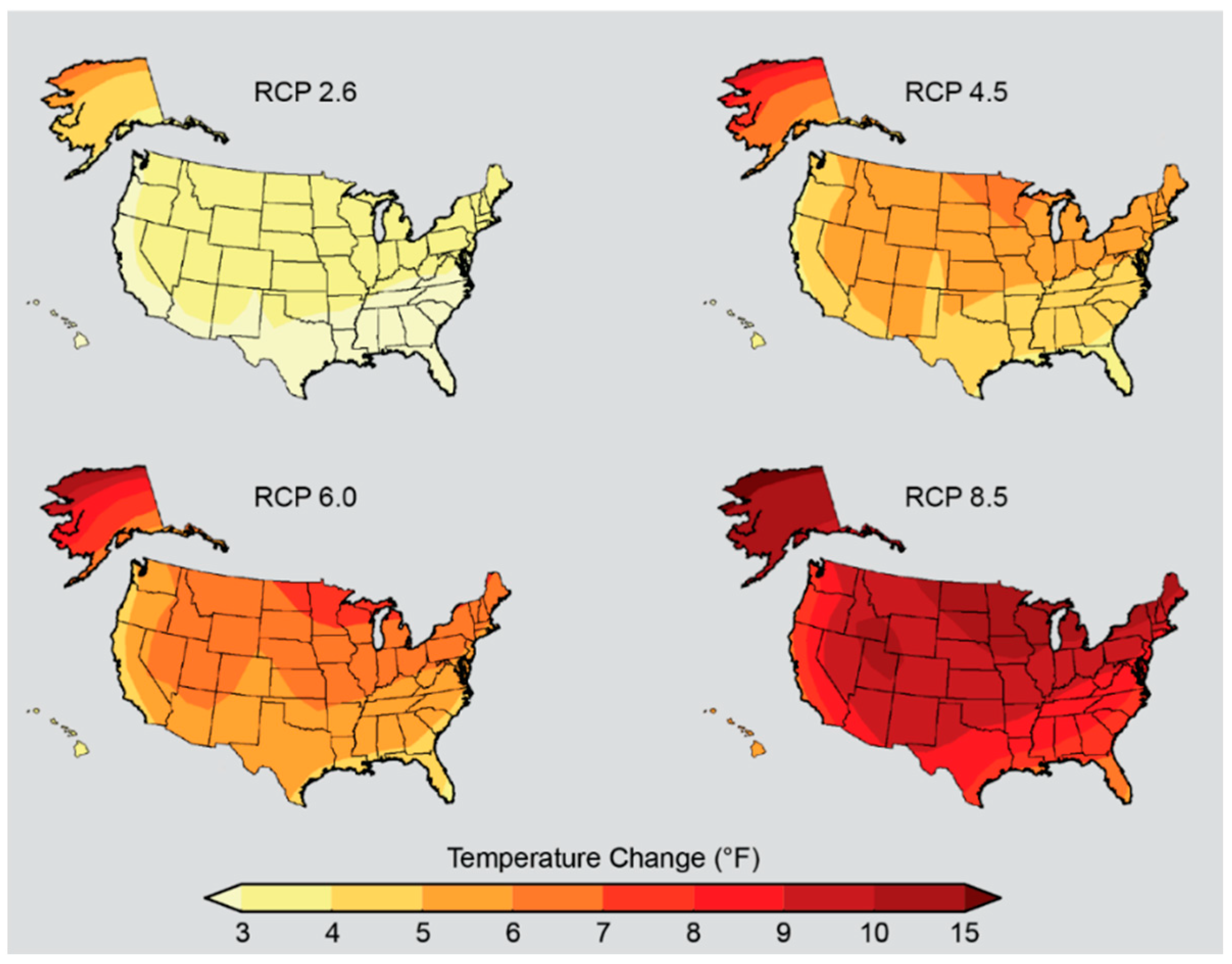
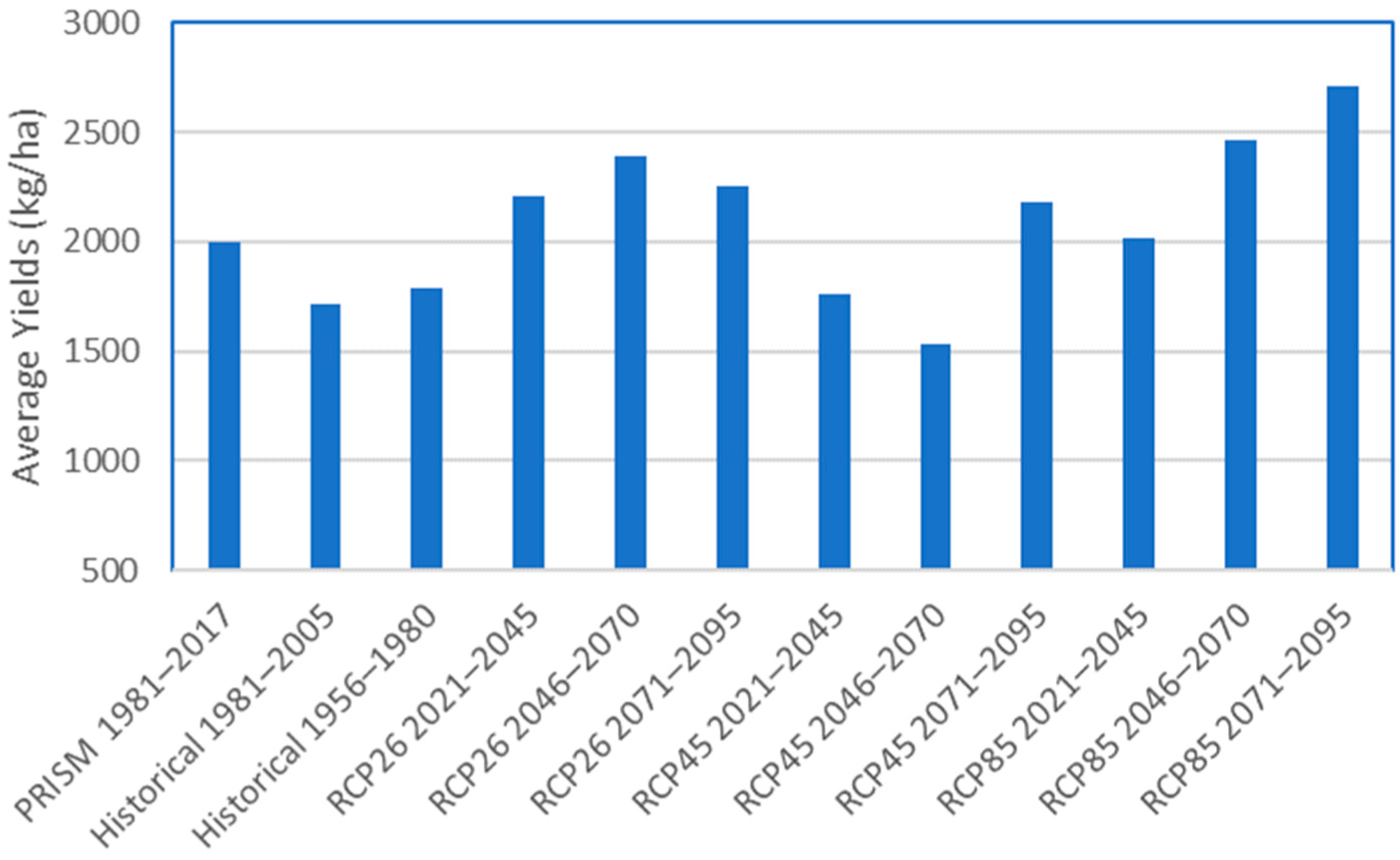
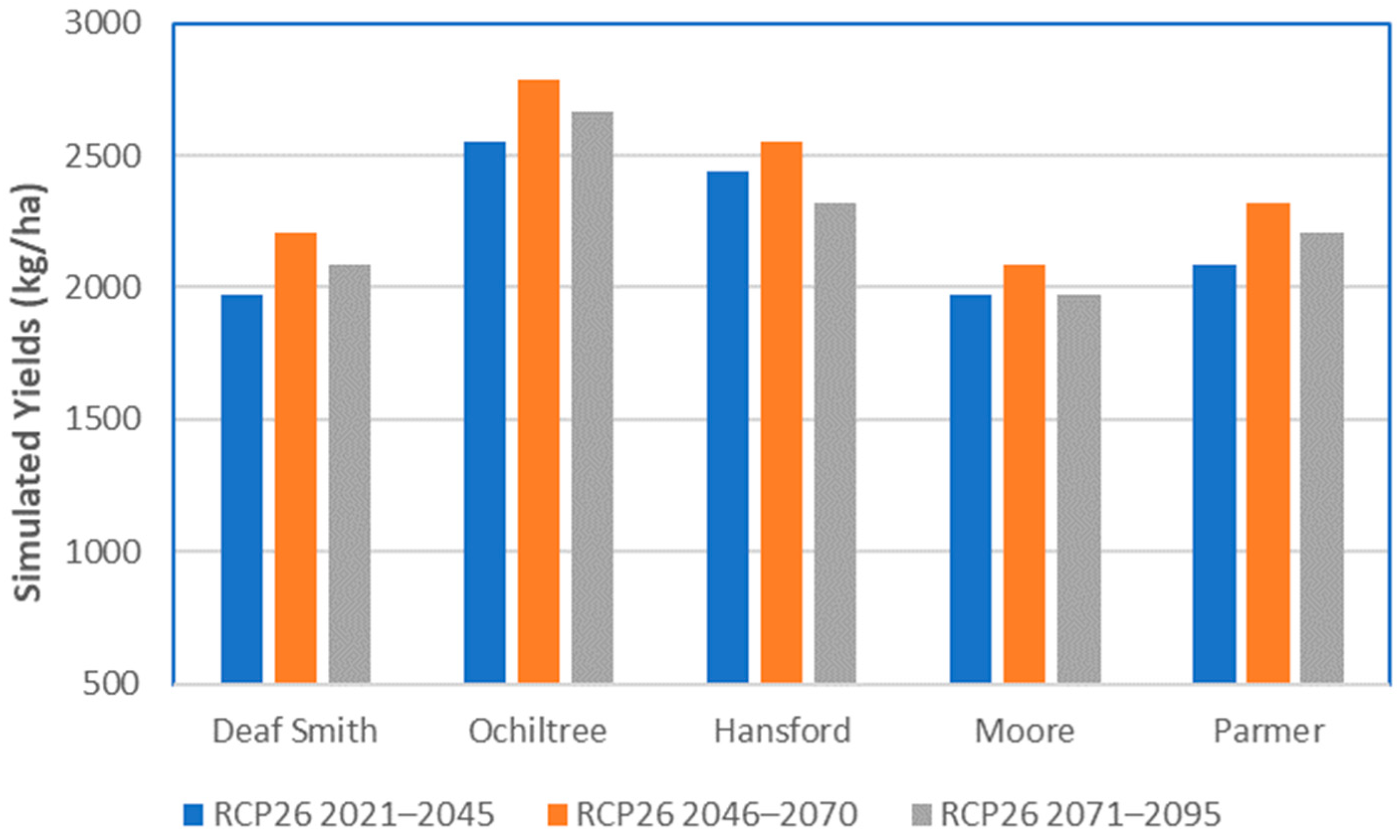
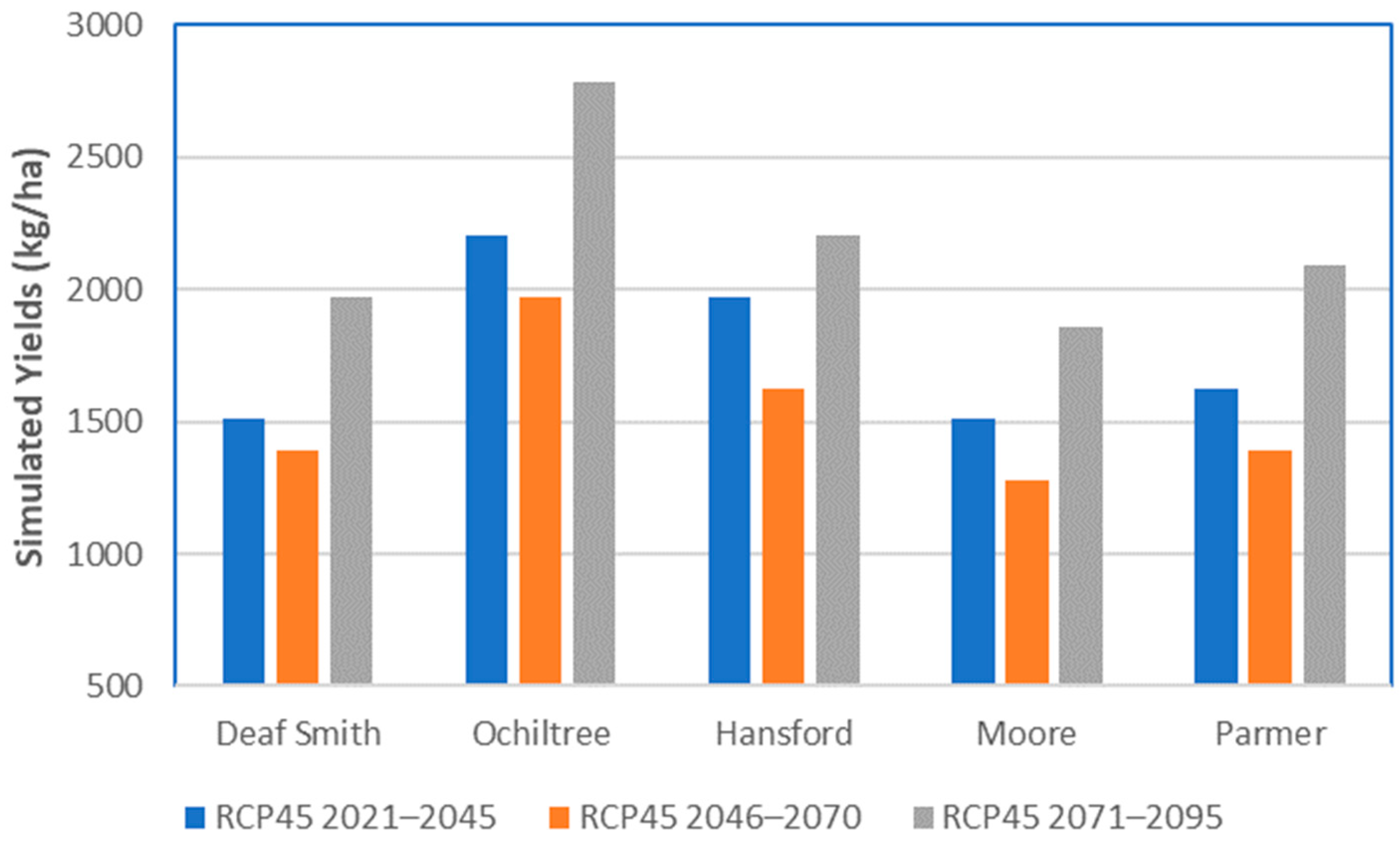
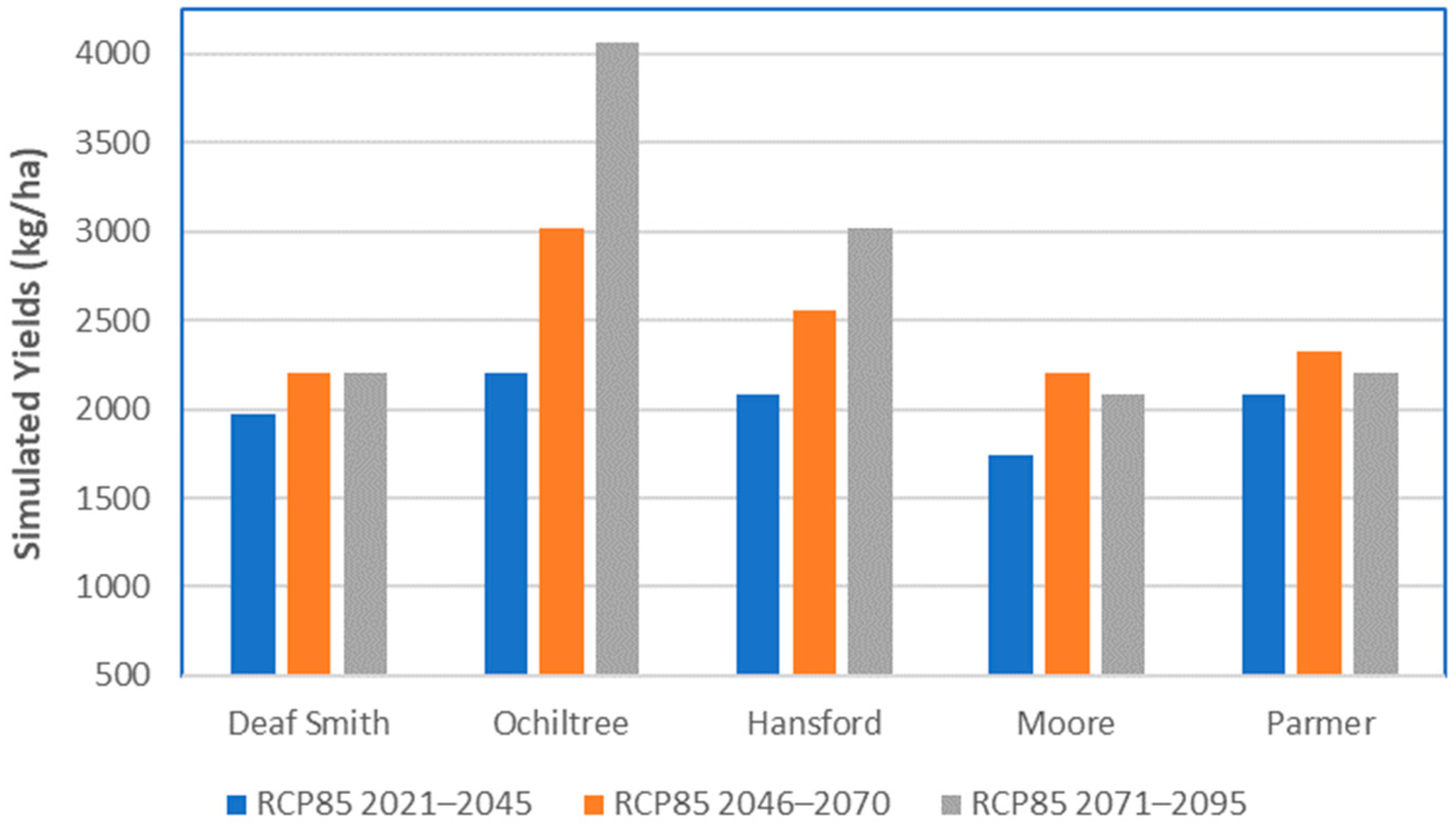
| Parameters | Units | Average | Maximum | Minimum | Standard Deviation |
|---|---|---|---|---|---|
| Temperature Min | °C | 5.6 | 18.8 | −6.4 | 8.6 |
| Temperature Max | °C | 21.6 | 34.0 | 9.0 | 8.6 |
| Precipitation | mm | 42.0 | 90.6 | 11.7 | 23.5 |
| County | Lat | Long | Avg Yield | Max Yield | Min Yield | Median Yield | Standard Deviation | Elevation (m) |
|---|---|---|---|---|---|---|---|---|
| Deaf Smith | 34.9170 | −102.5979 | 2185.7 | 3201.2 | 1129.8 | 2185.7 | 544.7 | 1234 |
| Ochiltree | 36.1119 | −100.6665 | 1923.4 | 3295.3 | 894.4 | 1856.1 | 544.7 | 893 |
| Hansford | 36.3386 | −101.4570 | 2279.8 | 3328.9 | 1412.3 | 2138.6 | 524.6 | 982 |
| Moore | 35.9988 | −102.1102 | 2656.4 | 3927.5 | 1681.3 | 2683.3 | 517.8 | 1140 |
| Parmer | 34.6710 | −102.4811 | 2273.1 | 3147.4 | 1170.2 | 2259.6 | 504.4 | 1188 |
| Average | - | - | 2266.4 | 3382.7 | 1257.6 | 2226.0 | - | - |
| Parameters | Units | Average | Maximum | Minimum | Standard Deviation |
|---|---|---|---|---|---|
| Planted Acreage | mil ha | 6.0 | 3.3 | 1.4 | 0.4 |
| Yield | kg/ha | 1896.5 | 2488.3 | 1076 | 309.4 |
| Production | bil kg | 2.6 | 5.1 | 0.8 | 0.9 |
| Price Received | $/kg | 0.17 | 0.28 | 0.08 | 0.06 |
| Fertilizer | Unit | Average | Maximum | Minimum | Standard Deviation |
|---|---|---|---|---|---|
| Nitrogen | kg/ha | 88.3 | 125.6 | 52.7 | 37.2 |
| Phosphate | kg/ha | 43.8 | 60.5 | 25.8 | 19.7 |
| Potash | kg/ha | 23.9 | 54.9 | 4.5 | 14.3 |
| Date | Operation |
|---|---|
| 15 February | Apply nitrogen, phosphate, and potash |
| 1 May | Harvest |
| 30 June | Kill |
| 15 July | Till |
| 1 August | Disk |
| 15 October | Plant |
| 30 November | Apply nitrogen, phosphate, and potash |
| Scenarios | 1956–1980 | 1981–2005 | 1981–2017 | 2021–2045 | 2046–2070 | 2071–2095 |
|---|---|---|---|---|---|---|
| Historical CMIP5 | X | - | - | - | - | - |
| Historical PRISM | - | Baseline | - | - | - | - |
| PRISM | - | - | Baseline | - | - | - |
| RCP2.6 | - | - | - | X | X | X |
| RCP4.5 | - | - | - | X | X | X |
| RCP8.5 | - | - | - | X | X | X |
| United States Maximum | United States Minimum | Texas Maximum | Texas Minimum | |
|---|---|---|---|---|
| RCP 2.6 | 3.3 | <1.7 | 2.2 | <1.7 |
| RCP 4.5 | 5.6 | 1.7 | 3.3 | 1.7 |
| RCP 6.0 | >8.3 | 2.2 | 3.3 | 2.2 |
| RCP 8.5 | >8.3 | 3.3 | 5.6 | 3.9 |
| County | PRISM 1981–2017 | Historical CMIP5 1956–1980 | Historical PRISM 1981–2005 |
|---|---|---|---|
| Deaf Smith | 2091.5 | 1741.8 | 1627.5 |
| Ochiltree | 2205.8 | 1856.1 | 1970.5 |
| Hansford | 1856.1 | 1856.1 | 1741.8 |
| Moore | 1741.8 | 1627.5 | 1506.4 |
| Parmer | 2091.5 | 1856.1 | 1741.8 |
| Average | 1997.4 | 1788.9 | 1714.9 |
| County | RCP2.6 2021–2045 | RCP2.6 2046–2070 | RCP2.6 2071–2095 |
|---|---|---|---|
| Deaf Smith | 1972.6 | 2204.7 | 2088.7 |
| Ochiltree | 2552.8 | 2784.9 | 2668.9 |
| Hansford | 2436.8 | 2552.8 | 2320.8 |
| Moore | 1972.6 | 2088.7 | 1972.6 |
| Parmer | 2088.7 | 2320.8 | 2204.7 |
| Average | 2204.7 | 2390.4 | 2251.1 |
| Max | 2555.5 | 2784.2 | 2669.9 |
| Min | 1970.5 | 2091.5 | 1970.5 |
| County | RCP4.5 2021–2045 | RCP4.5 2046–2070 | RCP4.5 2071–2095 |
|---|---|---|---|
| Deaf Smith | 1508.5 | 1392.5 | 1972.6 |
| Ochiltree | 2204.7 | 1972.6 | 2784.9 |
| Hansford | 1972.6 | 1624.5 | 2204.7 |
| Moore | 1508.5 | 1276.4 | 1856.6 |
| Parmer | 1624.5 | 1392.5 | 2088.7 |
| Average | 1763.8 | 1531.7 | 2181.5 |
| Max | 2205.8 | 1970.5 | 2784.2 |
| Min | 1506.4 | 1277.8 | 1856.1 |
| County | RCP8.5 2021–2045 | RCP8.5 2046–2070 | RCP8.5 2071–2095 |
|---|---|---|---|
| Deaf Smith | 1972.6 | 2204.7 | 2204.7 |
| Ochiltree | 2204.7 | 3017.0 | 4061.3 |
| Hansford | 2088.7 | 2552.8 | 3017.0 |
| Moore | 1740.6 | 2204.7 | 2088.7 |
| Parmer | 2088.7 | 2320.8 | 2204.7 |
| Average | 2019.1 | 2460.0 | 2715.3 |
| Max | 2205.8 | 3019.6 | 4062.0 |
| Min | 1741.8 | 2205.8 | 2091.5 |
| Historical | RCP 2.6 | RCP 4.5 | RCP 8.5 | |||||||||
|---|---|---|---|---|---|---|---|---|---|---|---|---|
| 81–17 | 56–80 | 81–05 | 21–45 | 46–70 | 71–95 | 21–45 | 46–70 | 71–95 | 21–45 | 46–70 | 71–95 | |
| Deaf Smith | 0.0 | −16.7 | −22.2 | −5.6 | 5.6 | 0.0 | −27.8 | −33.3 | −5.6 | −5.6 | 5.6 | 5.6 |
| Ochiltree | 0.0 | −15.8 | −10.5 | 15.8 | 26.3 | 21.1 | 0.0 | −10.5 | 26.3 | 0.0 | 36.8 | 84.2 |
| Hansford | 0.0 | 0.0 | −6.3 | 31.3 | 37.5 | 25.0 | 6.3 | −12.5 | 18.8 | 12.5 | 37.5 | 62.5 |
| Moore | 0.0 | −6.7 | −13.3 | 13.3 | 20.0 | 13.3 | −13.3 | −26.7 | 6.7 | 0.0 | 26.7 | 20.0 |
| Parmer | 0.0 | −11.1 | −16.7 | 0.0 | 11.1 | 5.6 | −22.2 | −33.3 | 0.0 | 0.0 | 11.1 | 5.6 |
| Historical | RCP 2.6 | RCP 4.5 | RCP 8.5 | |||||||||
|---|---|---|---|---|---|---|---|---|---|---|---|---|
| 81–17 | 56–80 | 81–05 | 21–45 | 46–70 | 71–95 | 21–45 | 46–70 | 71–95 | 21–45 | 46–70 | 71–95 | |
| Deaf Smith | 28.6 | 7.1 | 0.0 | 21.4 | 35.7 | 28.6 | −7.1 | −14.3 | 21.4 | 21.4 | 35.7 | 35.7 |
| Ochiltree | 11.8 | −5.9 | 0.0 | 29.4 | 41.2 | 35.3 | 11.8 | 0.0 | 41.2 | 11.8 | 52.9 | 105.9 |
| Hansford | 6.7 | 6.7 | 0.0 | 40.0 | 46.7 | 33.3 | 13.3 | −6.7 | 26.7 | 20.0 | 46.7 | 73.3 |
| Moore | 15.4 | 7.7 | 0.0 | 30.8 | 38.5 | 30.8 | 0.0 | −15.4 | 23.1 | 15.4 | 46.2 | 38.5 |
| Parmer | 20.0 | 6.7 | 0.0 | 20.0 | 33.3 | 26.7 | −6.7 | −20.0 | 20.0 | 20.0 | 33.3 | 26.7 |
Disclaimer/Publisher’s Note: The statements, opinions and data contained in all publications are solely those of the individual author(s) and contributor(s) and not of MDPI and/or the editor(s). MDPI and/or the editor(s) disclaim responsibility for any injury to people or property resulting from any ideas, methods, instructions or products referred to in the content. |
© 2024 by the authors. Licensee MDPI, Basel, Switzerland. This article is an open access article distributed under the terms and conditions of the Creative Commons Attribution (CC BY) license (https://creativecommons.org/licenses/by/4.0/).
Share and Cite
Salinas, C.; Osei, E.; Yu, M.; Guney, S.; Lovell, A.; Kan, E. Climate Change Effects on Texas Dryland Winter Wheat Yields. Agriculture 2024, 14, 232. https://doi.org/10.3390/agriculture14020232
Salinas C, Osei E, Yu M, Guney S, Lovell A, Kan E. Climate Change Effects on Texas Dryland Winter Wheat Yields. Agriculture. 2024; 14(2):232. https://doi.org/10.3390/agriculture14020232
Chicago/Turabian StyleSalinas, Cori, Edward Osei, Mark Yu, Selin Guney, Ashley Lovell, and Eunsung Kan. 2024. "Climate Change Effects on Texas Dryland Winter Wheat Yields" Agriculture 14, no. 2: 232. https://doi.org/10.3390/agriculture14020232
APA StyleSalinas, C., Osei, E., Yu, M., Guney, S., Lovell, A., & Kan, E. (2024). Climate Change Effects on Texas Dryland Winter Wheat Yields. Agriculture, 14(2), 232. https://doi.org/10.3390/agriculture14020232







